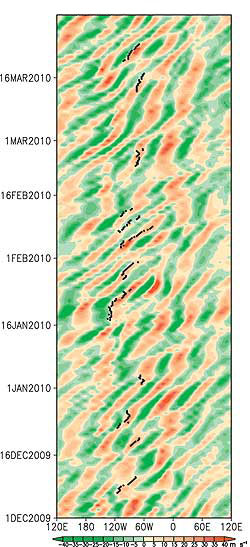February 1st, 2013
Key Findings
- El Niño winters tend to favor the persistence of a strengthened Pacific subtropical jet stream and a southward shifted Pacific storm track.
- The wave packets that populate the storm tracks travel eastward through downstream development towards the western Atlantic.
- Synoptic-scale transient eddies lower the pressure over the midlatitude Atlantic zone, affecting the southern lobe of NAO.
- The more frequent and higher persistence of those episodes during El Niño winters contributes to the prevalence of negative NAO conditions.
- These processes are studied for the 2009/2010 winter season, characterized by unusual storminess over the U.S., and a signature of both El Niño and strong negative NAO conditions. Surface cyclone development often occurs at the approach of an upper-level trough at the leading edge of the wave packets, which in turn is linked to a downstream evolution of wave packets originating from the Pacific storm track.
Ying Li and Ngar-Cheung Lau. Journal: Journal of Climate. DOI: 10.1175/JCLI-D-11-00377.1
Summary
El Niño-Southern Oscillation (ENSO) is the dominant pattern of interannual climate variability, and has strong influence on the atmospheric circulation around the globe. North Atlantic Oscillation (NAO) is another prominent mode of interannual variability in the Northern Hemisphere extratropics, and exerts a strong influence on the climate of the North Atlantic basin and the surrounding land areas. The main purpose of this study is to describe and assess of the interactions between these two prominent patterns of interannual climate variability.
In this study, we analyze daily data from a 2000-year simulation of pre-industrial climate, using GFDL’s global coupled climate model CM2.1, and compare those results with observations. Our goal is to examine the role of transient eddies in the ENSO/NAO relationship during anomalous episodes with duration of less than one month.
Based on the daily data analysis, this study offers a more detailed perspective of the eddy processes responsible for the ENSO/NAO relationships examined in our previous study using seasonal averages. Due to the low vertical resolution of the model stratosphere in CM2.1, the El Niño effect on the simulated extratropical stratosphere is very weak. We have conducted a follow-up study to explore the importance of stratosphere processes in the ENSO/NAO relationship using the new GFDL climate model (CM3) with a more realistic upper atmosphere.



